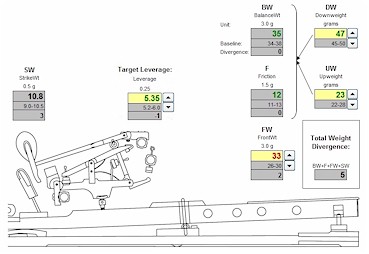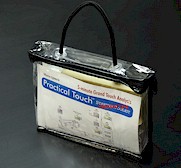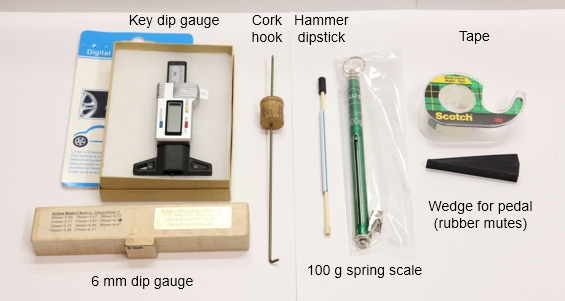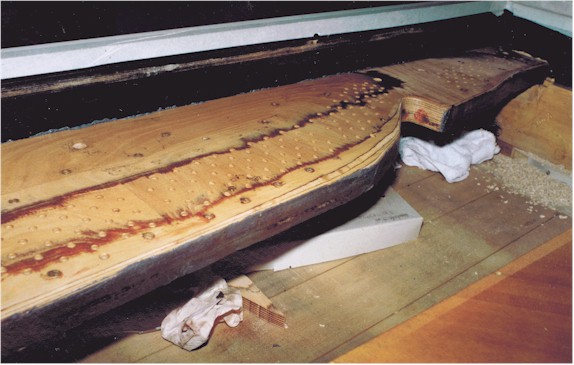Bonus Material
Practical Touch
 Practical Touch™ Analysis is a method for evaluating touch performance noninvasively in 4 easy steps
(2 or 3 additional
measurements improve precision) with the help of a calculator and toolkit.
Practical Touch™ Analysis is a method for evaluating touch performance noninvasively in 4 easy steps
(2 or 3 additional
measurements improve precision) with the help of a calculator and toolkit.
The calculator spreadsheet, available for download below, allows you to analyze your measurements and play what-if scenarios to determine the best strategy for optimizing touch performance.
Important: The Practical Touch Analysis calculator is in beta testing, and is made available for attendees of the author's Practical Touch classes. The author assumes no liability for any damage or data loss that using this calculator spreadsheet may cause. In the future, the calculator may be available for sale by itself or as part of a kit.
Please be aware that you will not be able to import data from this version into a future version of the calculator—you will need to retype your data.
Requirements and compatibility: The full version of the calculator requires Microsoft Excel 2003 or later. Macros must be enabled to make the buttons that reset measurement and calculator fields work. You can use the calculator without the buttons, but you will need to double-enter multiple values. Download the simplified version to run the calculator on tablets and smartphones or in any spreadsheet applications that don't fully support Excel features and VBA macros.
Warning: Cells with formulas and spinner buttons are protected only in Microsoft Excel. Other spreadsheet programs such as Apple Numbers for IOS do not observe Excel's cell locking. Be extra careful to avoid overwriting the formulas. If you wish to edit formulas in Excel, remove protection from the sheet in question.
View calculator release notes.
- Full Practical Touch™ calculator for MS Excel 2003, version 20140605
- Simplified Practical Touch™ calculator for Apple Numbers on
iPad and OSX, version 20140606
- Simplified Practical Touch™ calculator for other tablets and smartphones,
version 20140606
- Startup Toolkit User's Guide (see below)
Click here to receive updates about Practical Touch via email. We promise not to sell or misuse your email address.
View descriptions and class handouts for Practical Touch and other classes taught by Mario Igrec.
Practical Touch Analysis Startup Toolkit
Temporarily out of stock

Introductory Price: $100.00 (reg. $150)
Shipping (priority mail): $10.00 US, $30 Canada, $38 other countries
Included in the kit:

The contents may vary in appearance, but is functionally will be the same.
For information on how to use the toolkit, read the Startup Toolkit User's Guide.
Additional information is available in the Practical Touch Analysis class handout.
Temporarily out of stock
Pinblock: To Replace or not to Replace?

QUESTION: When performing a partial rebuilding of a pre-WW II, high-quality grand piano, if the pinblock seems to be in good condition, should one still replace it?
ANSWER: I have to start with a counter-question: Has the piano been exposed to low and high humidity? The soundboard and bridge caps usually tell the story—if those are cracked, the pinblock too was subject to compression set (see "Compression Set and Cracks" in the Rebuilding chapter, page 457) and was compromised to some degree. Tuning the piano usually reveals pinblock problems, but can be deceiving, especially during a humid season. A visual inspection may not identify cracked inner plies.
By replacing the pinblock:
- You are restarting the clock
- You can use a tuning pin size that tunes nicely (2/0 or even 1/0 in American vintage grands)
- You are ensuring consistency by choosing the pinblock material and controlling how you drill the holes
- ... but you are adding cost
Replacing a full-fit pinblock is challenging for a novice. Not fitting the block well in all dimensions poses risks, from tuning instability, to stresses on the case, to even cracking the plate.
By not replacing the pinblock, there is a risk that:
- The block is or will become cracked, especially in the low bass
- Tuning pins will have uneven torque, even after reaming (always drill/ream holes all the way through or you may crack off the bottom plies)
- The thicker pins will tune slightly more coarsely
But, if the choice is between a cheap replacement pinblock (which is bound to develop uneven torque) and keeping an old block that's holding up well (at 30-40% RH, test every pin), I'd go with keeping the old block. For a professional rebuilding operation, though, replacing the pinblock is the only way to guarantee results. Addressing a pinblock problem requires moving the piano, restringing it, and pulling out the plate—a costly proposition.
Inharmonicity Measurements in Table 4, p. 102
Table 4 in Pianos Inside Out lists measured and/or calculated frequencies of the first eight partials of each note A in a 1923 Steinway A III. For the wrapped bass strings on notes A0, A1, and A2, the frequencies were measured or estimated from measurements performed by Verituner software. The frequencies of partials for A3, A4, A5, A6, and A7 were calculated using Robert Young's inharmonicity formula for plain steel wire, as it appears in Eq. 9 in his seminal 1952 paper entitled "Inharmonicity of Plain Wire Piano Strings."
The formula, ready to use in a spreadsheet, is:
=(34000000000000*H45^2)/(E45^2*F45^4)
where:
- H45 is the string's core diameter, in cm
(e.g. for C8 and American wire it is 0.0787; for German wire, 0.0775) - E45 is the theoretical frequency of the note's partial 1, in Hz, calculated as:
=E44*(2^(1/12))
where E44 is the frequency, in Hz, of the previous chromatic note
(i.e. G#3 if E45 is for A3; A0 is 27.5 Hz) - F45 is the speaking length in cm
Create a row for each note, add columns for the note number and name, add all columns referenced above, and add a column for the coefficient of inharmonicity. Paste the above formula in that column, then change the cell references to your locations, and copy the formula down to populate all pertinent rows.
Wrapped Bass Strings
Calculating the inharmonicity of wrapped bass strings has never been fully resolved to my knowledge. Various formulas exist, but their results differ, and those differ from the actual measurements taken partial by partial. For more, see Rick Baldassin's two articles on inharmonicity in the July 1988 and December 1988 issues of Piano Technicians Journal (both are listed in the Selected Bibliography in Pianos Inside Out).
 Visit us on Facebook.
Visit us on Facebook.